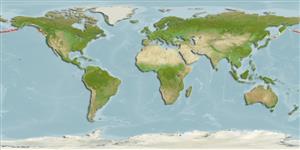Actinopterygii (ray-finned fishes) >
Scorpaeniformes (Scorpionfishes and flatheads) >
Sebastidae (Rockfishes, rockcods and thornyheads) > Sebastinae
Etymology: Sebastes: Greek, sebastes = august, venerable (Ref. 45335).
Environment / Climate / Range
Ecology
Marine; demersal; depth range 70 - 558 m (Ref. 27437). Temperate, preferred ?; 55°N - 45°N
Northeast Pacific: Bowers Bank and Petrel Bank in the Aleutian chain to Newport, Oregon, USA.
Length at first maturity / Size / Weight / Age
Maturity: Lm 23.0 range ? - ? cm
Max length : 38.0 cm TL male/unsexed; (Ref. 27437); max. reported age: 47 years (Ref. 39247)
Dorsal
spines
(total): 13;
Dorsal
soft rays
(total): 13-15;
Anal
spines: 3;
Anal
soft rays: 6 - 7;
Vertebrae: 26. Head spines strong to moderate - nasal, preocular, postocular, tympanic and parietal spines present, nuchals usually absent, supraocular and coronal spines absent (Ref. 27437). Weak symphyseal knob; 2nd anal fin spine longer than 3rd (Ref. 27437). Caudal fin moderately indented (Ref. 6885). Pink to red with irregular dark markings interrupted by lighter band along two thirds of lateral line; caudal fin with dark membranes and pink or red band terminating fin; anal fin has black between 2nd and 3rd spines; tip of spinous dorsal black (Ref. 27437).
Viviparous (Ref. 34817). Too small to be of high commercial value (Ref. 27437).
Life cycle and mating behavior
Maturity | Reproduction | Spawning | Eggs | Fecundity | Larvae
Eschmeyer, W.N., E.S. Herald and H. Hammann, 1983. A field guide to Pacific coast fishes of North America. Boston (MA, USA): Houghton Mifflin Company. xii+336 p. (Ref. 2850)
IUCN Red List Status (Ref. 115185)
CITES (Ref. 94142)
Not Evaluated
Threat to humans
Harmless
Human uses
Fisheries: minor commercial; gamefish: yes
More information
ReferencesAquacultureAquaculture profileStrainsGeneticsAllele frequenciesHeritabilityDiseasesProcessingMass conversion
Tools
Special reports
Download XML
Internet sources
